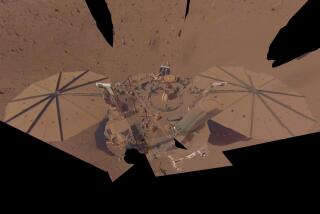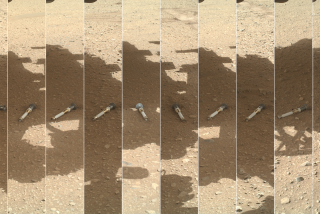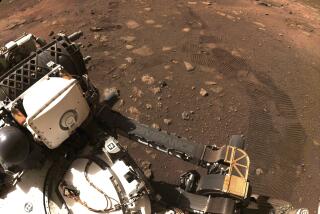10-year-old Opportunity rover finds old ‘drinking water’ on Mars
Old rovers can indeed learn new tricks. Rolling into its 10th anniversary on the Red Planet, Opportunity has discovered clay minerals showing that life-friendly water flowed on Mars in the earliest epoch of its history.
The findings indicate that Curiosity’s groundbreaking discovery last year of clays capable of hosting microbes like those on Earth was no fluke, experts said.
“We’ve basically found strong evidence for clays on both sides of the planet,” said Cornell University planetary scientist Steve Squyres, lead scientist for NASA’s Mars Exploration Rover program and coauthor of a report published in Friday’s edition of the journal Science.
Opportunity has seen better days since it landed on Mars on Jan. 24, 2004. It has a bad front right wheel, its robotic arm is suffering from mechanical arthritis and it has even had a “senior moment” with its flash memory, Mars Exploration Rover project manager John Callas said in a briefing Thursday.
But Opportunity is far from done with Mars. Its discovery of water that’s not too acidic to support life shows that it has a lot more exploring to do as it heads into its second decade, Callas said.
“This creates some of the most scientifically interesting opportunities of the entire mission,” Callas said.
When Opportunity and its now-defunct twin Spirit landed on the Martian surface, they probed the planet for evidence of water in the past. They found mineral and chemical signs of the liquid’s past existence in the Meridiani Planum area, including spherules -- blueberry-shaped concretions of the mineral hematite -- which are thought to have formed in running water.
But many of those chemical clues came in the form of sulfates, a sign of highly acidic water that would not have been able to support life as we know it.
Since Opportunity’s arrival at the rim of Endeavour crater in 2011, the picture has changed dramatically, Squyres said. The rover has discovered signs of clay minerals that form in the presence of low-acidity, pH-neutral water.
The clay-rich rocks are geographically close to the sulfate-rich rocks, but they were vastly separated by time, Squyres said. In fact, the clays came from a much deeper layer of rock that represented the earliest epoch in Martian history.
“These are some of the oldest rocks we’ve looked at — probably the oldest rocks that we’ve looked at with Opportunity,” he said.
The analysis suggests that a neutral-water environment existed first, and that the acidic environment came later, according to the study.
“The older you look, the better it gets in terms of habitability at this location,” said study leader Raymond Arvidson, a planetary scientist at Washington University in St. Louis.
Arvidson pointed to the evidence for neutral water from fractured rocks like one named Esperance, recently studied at a segment along Endeavour’s rim called Cape York.
“If I were there back when this material was being emplaced and altered, and I had my summer house, this is where I would drill to get good drinking water,” Arvidson said.
Of course, this doesn’t mean that all of Mars was friendly to microbes, and scientists have a long way to go to figure out whether there was ever life at all. That’s a job for a future mission -- say, the Mars 2020 rover, which would cache samples for another spacecraft to bring back to Earth.
“These results demonstrate that early Mars was habitable, but this does not mean that Mars was inhabited,” Caltech geologist John Grotzinger, the lead scientist for the Curiosity mission and coauthor of the Science report, wrote in a commentary. “Even for Earth, it was a formidable challenge to prove that microbial life existed billions of years ago.”
Unlike Curiosity, a high-tech geology lab on wheels that landed on Mars in 2012, Opportunity can’t directly detect carbon or nitrogen, elements necessary for life as we know it. The elder rover also has no way to determine the age of the materials it encounters. That means it’s impossible to say for sure exactly how old these clay-rich rocks are, or how much later the sulfate-rich rocks emerged.
Still, Squyres estimated that the clay-rich rocks are probably somewhere on the order of 4 billion years old, and the sulfate-rich rocks probably came a few hundred million years later. How the environment became more acidic in that time span remains a mystery, he said.
With more than 3,500 Martian days, or sols, under its belt, Opportunity has long outlived its original 90-sol mission. Though the rover was designed to cover only about 1 kilometer of Martian turf, it has traveled 38.7 km so far, or slightly more than 24 miles. It’s no wonder the vehicle is showing its years.
Reflecting on the rover’s 10-year anniversary on Mars, Callas observed that Opportunity and Spirit (which sent its last message to Earth in 2010) changed the way people view their place in the solar system.
“In addition to being earthlings, because of these rovers, we have become Martians too -- dual citizens, if you will,” Callas said.
But age is just a number. Opportunity continues to find new ways to look at the Red Planet. The trek to the rim of Endeavour crater was enough to encounter rocks with completely different chemistry and mineralogy, Squyres said.
“We really felt we had a brand-new mission,” he said. “It was like a completely new landing site.”







